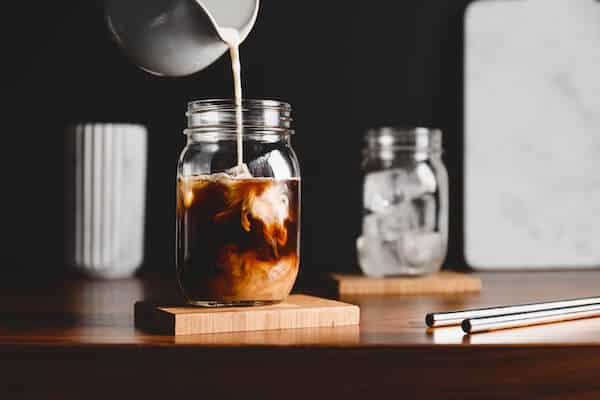Are you seeking a creamy, delicious dairy-free coffee drink that won’t break your calorie bank? Look no further than the oat milk latte! Oat milk is becoming increasingly popular among health-conscious individuals, baristas, and the lactose intolerant alike. Not only is it packed with nutrition like fiber and protein, but it tastes excellent in lattes too!
The number of calories in an oat milk latte depends on the size of the latte, the amount of coffee and oat milk used, and any additional flavorings or sweeteners. On average, a 16 oz (Grande) oat milk latte with no added flavorings or sweeteners contains around 190-230 calories.
In this article, we’ll discuss what makes an oat milk latte so special, share details on its caloric content relative to other drinks, give instructions on how to make one at home using just basic ingredients, and even provide ideas for similar oat milk coffee creations. Let’s get started!

How To Make A Low-Calorie Oat Milk Latte At Home
In terms of nutrition, oat milk is a great option for those looking for a lower-fat alternative to dairy milk. Oat milk typically has fewer calories and less fat than whole milk and can also be lower in sugar depending on the brand and flavor. Oat milk also has a creamy, slightly sweet flavor that pairs well with coffee. Plus, it’s easy to find at most grocery stores, and you can make it at home if you’re feeling adventurous.
To make an oat milk latte, you’ll need a few ingredients:
- Espresso or strong brewed coffee: The base of any latte is espresso, which is made by forcing hot water through finely-ground coffee beans. If you do not have an espresso machine, you can use strong brewed coffee instead. Just make sure it’s brewed extra strong so that it can stand up to the milk.
- Oat milk: Look for unsweetened oat milk at the grocery store, as some brands may add sugar or other sweeteners. You can use regular or barista-style oat milk, which is formulated to froth well. If you can’t find oat milk, you can substitute another non-dairy milk like almond, soy, or coconut.
- Sweetener (optional): If you like your lattes on the sweeter side, you can add a sweetener like maple syrup, honey, or agave nectar. You can also use flavored syrups like vanilla or caramel.
Now that you have your ingredients, here’s how to make an oat milk latte:
- Brew the espresso or coffee: If you’re using an espresso machine, make a shot of espresso. If you’re using coffee, brew it extra strong. You’ll need about 2 ounces of espresso or 6-8 ounces of coffee.
- Froth the oat milk: You can froth the oat milk using a milk frother, a french press, or a whisk. If you’re using a milk frother or French press, heat the oat milk on the stove or in the microwave until it’s warm but not boiling. Froth the milk until it’s thick and creamy but not too bubbly. If you’re using a whisk, you can froth the milk directly in the saucepan on the stove.
- Combine the espresso and frothed oat milk: Pour the espresso into a mug or glass. Slowly pour the frothed oat milk over the espresso, holding back the foam using a spoon until you’ve added most of the milk. Then spoon the foam on top.
- Add sweetener (optional): If you like your latte sweet, stir in a teaspoon or two of your favorite sweetener.
- Enjoy: Sip and enjoy your delicious oat milk latte!
Making an oat milk latte is easy and can be customized to your taste preferences. Try experimenting with different sweeteners or flavors to create your perfect latte.

4 Different Ways To Make An Oat Milk Latte At Home
Using A Coffee Steamer:
- Heat up a cup of oatmilk on the stove or in the microwave until it’s warm.
- Pour the warmed oat milk into a coffee steaming pitcher.
- Use a steaming wand to steam the milk, holding it just beneath the surface so it creates a nice froth.
- Make a shot of espresso with an espresso machine and pour it into a mug.
- Pour the steamed and frothed oat milk on top of the espresso shot.
Using The Stove Top:
- Heat up a cup of oat milk on the stove until it’s warm, stirring occasionally.
- Make a shot of espresso and pour it into a mug.
- Pour the warmed oat milk on top of the espresso shot.
Using The Microwave:
- Pour a cup of oat milk into a container with a water-tight lid. Shake it vigorously until you see the desired amount of froth.
- Pour the shaken oat milk into a microwave-safe container and heat for 1-2 minutes until it’s warm.
- Make an espresso shot and pour it into a mug.
- Pour the warmed oat milk on top of the espresso shot.
Iced Oat Milk Latte:
- Fill a glass with ice cubes.
- Pour a cup of oat milk over the ice.
- Make an espresso shot using an espresso machine and pour it over the oat milk.
- Stir and enjoy!
Note: You can also use a milk frother to froth the milk for any of these methods, instead of a steaming wand. And feel free to add any sweetener or flavorings to your latte as desired.

What Is The Difference Between Barista Oat Milk and Regular Oat Milk?
Oat milk has become an increasingly popular alternative to dairy milk in recent years, and for good reason. It’s a creamy, nutritious, and sustainable plant-based milk that’s easy to find in most grocery stores. But did you know that there are different types of oat milk available, including standard oat milk and barista oat milk? While they may look similar, there are some key differences between the two.
Standard Oat Milk
Standard oat milk is the type of oat milk that you’ll find in your grocery store. It’s made by blending oats with water and then straining out the solids. The resulting liquid is a creamy, slightly sweet milk that’s perfect for adding to cereal, smoothies, or coffee. Standard oat milk usually contains some additives or stabilizers, which means it may separate or curdle when heated.
Barista Oat Milk
Barista oat milk, on the other hand, is specifically formulated for use in coffee shops and cafes. It’s made in a similar way to standard oat milk, but with a few key differences. Barista oat milk can be made with a higher percentage of oats to water, which gives it a thicker, creamier texture that’s perfect for frothing and steaming. It often also contains additional stabilizers or emulsifiers to help it hold its texture when heated.
The main difference between standard oat milk and barista oat milk is their texture and how they perform when heated. Standard oat milk may separate or curdle when added to hot coffee, while barista oat milk will hold its texture and create a rich, velvety foam. This makes it ideal for use in lattes, cappuccinos, and other espresso-based drinks.

Calories In An Oat Milk Latte
The table below table lists the nutritional information for a variety of milk types and milk-based latte drinks that you’ll find at your favorite coffee shops. From the classic whole milk to the trendy oat milk, this chart breaks down the calorie count, fat content, carbs, sugar, and protein in each drink. And yes, we’ve included the most popular oat milk latte variations that you can’t get enough of!
Whether you’re a fitness enthusiast looking for low-fat options or a vegan who wants to steer clear of dairy, this chart will help you make the best choice for your taste buds and dietary needs.
Latte Nutritional Info

Can I Use Oat Milk In Any Type Of Coffee Drink?
Yes, oat milk can be used in virtually any coffee drink, from lattes and cappuccinos to Americanos and cold brews. Oat milk has a creamy texture and a slightly sweet, nutty flavor that goes well with coffee. It’s also a great dairy-free option for those with lactose intolerance or who prefer a plant-based diet. In fact, many coffee shops now offer oat milk as a standard option for customers to use in their drinks.

Oat Milk Coffee Variations
- Oat Milk Cappuccino – Brew a shot (or two) of espresso and transfer it into a mug. Then steam 8 oz of oat milk and pour it over the espresso, holding back the foam with a spoon. Spoon the remaining foam on to the milk. Optional: sprinkle with cocoa powder or cinnamon.
- Oat Milk Flat White – Brew a double shot of espresso and pour it into your mug. Steam 6 oz of oat milk and pour it over the espresso, holding back the foam with a spoon. Add the remaining foam on top of the milk.
- Oat Milk Macchiato – Brew a shot of espresso and pour it into a demitasse cup. Steam 2 oz of oat milk and pour it over the espresso, holding back the foam with a spoon.
- Oat Milk Mocha – Brew a shot or two of espresso and pour it into your cup. Add 1-2 tablespoons of chocolate syrup and stir until combined. Steam 8 oz of oat milk and pour it over the espresso mixture. Optional: top with whipped cream and chocolate shavings.
- Oat Milk Americano – Brew a double shot of espresso and pour it into a cup. Add 8-10 ounces of hot water and stir. Steam 2 oz of oat milk and pour it over the top of the Americano, holding back the foam with a spoon.
Calorie count can vary based on the amount of oat milk used and any additional flavorings or sweeteners added. Generally, a 16 oz oat milk cappuccino can range from 80-120 calories, a 16 oz oat milk flat white can range from 110-170 calories, a 2 oz oat milk macchiato can range from 20-30 calories, a 16 oz oat milk mocha can range from 200-300 calories, and a 16 oz oat milk Americano with no additional flavorings or sweeteners is approximately 10-15 calories.
Does Oat Milk Curdle In Coffee?
Oat milk can curdle in coffee under certain conditions. Oat milk contains proteins that can interact with the acidity of coffee and cause it to curdle or separate. This can be more likely to happen if the coffee is very hot, or if the oat milk is not fresh.
However, some oat milk brands are specially formulated for use in coffee and are less likely to curdle. Additionally, some techniques can help prevent oat milk from curdling in coffee, such as preheating the oat milk or slowly pouring it into the coffee while stirring.
If your oat milk is curdling in your coffee, you can try switching to a different brand of oat milk, or experimenting with different temperatures and pouring techniques to find a method that works for you. For more tips, check out this article!
How Does Oat Milk Taste In Coffee?
Oat milk has a unique taste that can complement the flavor of coffee in a different way than traditional dairy milk. I describe oat milk as slightly sweet, creamy, and nutty, with a texture that is similar to dairy milk.
When combined with coffee, oat milk can create a smooth and creamy texture that enhances the flavors of the coffee. The natural sweetness of oat milk can also help to balance out any bitterness in the coffee.
However, the taste of oat milk in coffee can also depend on the brand and the specific type of oat milk used. Some oat milk brands may have a stronger oat flavor, while others may be more neutral in taste. It’s always a good idea to try different brands and types of oat milk to find the one that you enjoy the most in your coffee. If you are looking for a recommendation, check out this article, Best Oat Milk Brands For Coffee.
Is Oat Milk Good For Frothing In Coffee Drinks?
If you’ve ever tried to froth non-dairy milk alternatives in your coffee, you may have noticed that some types of milk don’t hold up as well as others. Soy milk and almond milk, for example, can be more difficult to froth and may not produce the same creamy texture as dairy milk. However, oat milk has been shown to be a great option for frothing.
One of the main reasons that oat milk is so good for frothing is that it contains special additives that help to create a smooth and creamy texture when it is steamed. Additionally, oat milk has a higher protein content than some other non-dairy milk alternatives, which can also contribute to a better froth.
To froth oat milk in your coffee, you will need a milk frother or a steam wand on your espresso machine. Simply pour your desired amount of oat milk into a frothing pitcher, and heat it up until it reaches the desired temperature. Then, use the steam wand or milk frother to create a creamy and frothy texture.
One thing to keep in mind when frothing oat milk is that it can be more prone to curdling than dairy milk. This is because oat milk contains proteins that can interact with the acidity of coffee and cause it to curdle. To avoid this, it’s a good idea to heat up your oat milk before adding it to your coffee and to pour it slowly while stirring to ensure that it mixes well with the coffee. Check out this article for more tips and recommendations about frothing oat milk.

How Oat Milk Affects The Flavor Of Coffee
Oat milk can affect the flavor of coffee, but it depends on personal taste and the brand of oat milk being used. Some people may find that oat milk has a slightly sweeter and nuttier flavor than dairy milk, which can add a unique taste to their coffee. However, others may not notice much of a flavor difference.
It’s important to remember that not all oat milk brands are created equal. Some oat milk brands may have added sugars or flavors that can alter the taste of your coffee, while others may have a more neutral flavor that doesn’t affect the taste of the coffee as much. It’s a good idea to experiment with different oat milk brands and types to find one that works best for you and your coffee preferences.
Another factor to consider is the type of coffee you are using. Strong and bold coffee flavors may be less affected by the addition of oat milk, while the nutty taste of oat milk may more easily overpower lighter and more delicate coffee flavors.
Overall, the flavor of coffee with oat milk compared to dairy milk is subjective and can vary depending on personal taste and the type of coffee and oat milk being used. However, many people find that oat milk can be a delicious and unique addition to their coffee routine.
Final Thoughts
Oat milk lattes make for a delightful and creamy coffee drink. Whether you’re trying to limit calories, watch your sugar intake, or just want to switch up your coffee routine, it’s a great alternative to some of the more popular coffee drinks. While an oat milk latte gives off a cozy feeling while sipping on your favorite cup of java, there are multiple other ways to incorporate oat milk into your daily caffeine intake. The bottom line is that whatever type of latte you decide to indulge in make sure to embrace it with some friends and good conversation.
P.S. – I’ve also included the data table as text here so you can copy & paste it 🙂
| Latte 16 oz (Grande) | Calories | Fat (g) | Carbs (g) | Total Sugar (g) | Protein (g) |
|---|---|---|---|---|---|
| Oat Milk Latte, No Sugar | 197 | 7 | 26 | 10 | 6 |
| Barista Oat Milk Latte, No Sugar | 227 | 10 | 26 | 10 | 6 |
| Whole Milk Latte, No Sugar | 240 | 12 | 20 | 18 | 14 |
| Skimmed (Fat Free) Milk Latte, No Sugar | 143 | 0 | 20 | 18 | 14 |
| Reduced fat (2%) Milk Latte, No Sugar | 200 | 7 | 20 | 18 | 14 |
| Oat Milk Latte, 2 Sugars | 227 | 7 | 33 | 17 | 6 |
| Barista Oat Milk Latte, 2 Sugars | 257 | 10 | 33 | 17 | 6 |
| Whole Milk Latte, 2 Sugars | 270 | 12 | 27 | 25 | 14 |
| Skimmed (Fat Free) Milk Latte, 2 Sugars | 173 | 0 | 27 | 25 | 14 |
| Reduced fat (2%) Milk Latte, 2 Sugars | 230 | 7 | 27 | 25 | 14 |
| Starbucks Vanilla Oat Milk Latte | 190 | 8 | 23 | 7 | 4 |
| Dunkin Matcha Latte With Oat Milk | 250 | N/A | N/A | N/A | N/A |
| Chai Tea Oat Milk Latte Starbucks | 240 | 4.5 | 45 | 42 | 8 |
Now let’s dive deeper in all things oat milk related – check out these other articles!
Recent Posts
Oat milk is becoming a popular choice for coffee drinkers, but what is the best type of oat milk to use in your coffee? Some people prefer the thinner consistency of light oat milk, while others find...

